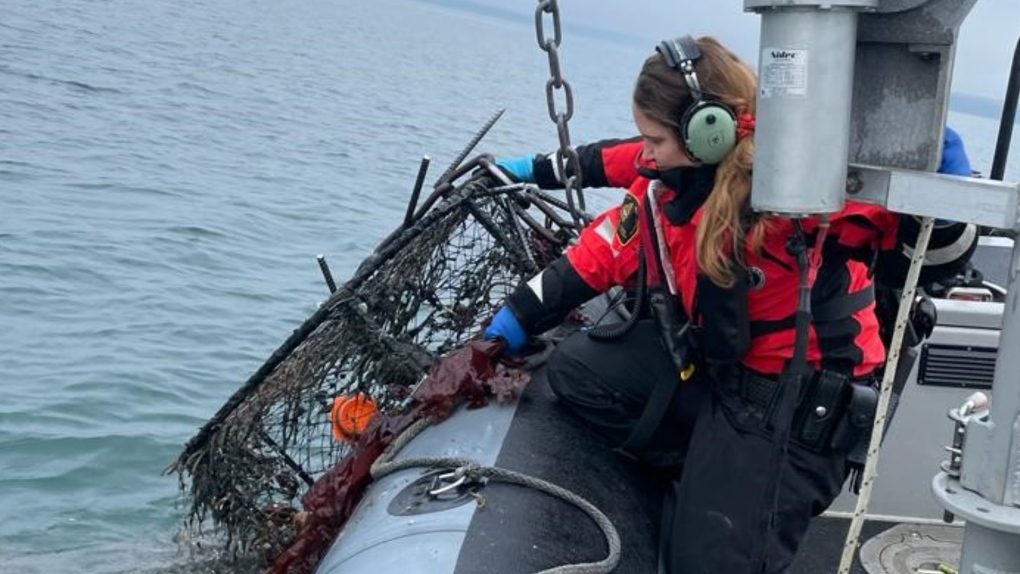270 illegal crab traps seized from Boundary Bay, federal officials say
 This photo, provided by the Department of Fisheries and Oceans, shows officials removing illegal crab traps from Boundary Bay.
This photo, provided by the Department of Fisheries and Oceans, shows officials removing illegal crab traps from Boundary Bay.
More than 900 crabs were freed from illegal traps in Boundary Bay last week, according to federal officials.
Between Jan. 23 and Jan 27, the Department of Fisheries and Oceans and the Canadian Coast Guard conducted a "ghost fishing" operation near White Rock.
"To counter suspected illegal fishing, fishery officers conduct dragging operations several times a year to retrieve lost, abandoned or illegally set gear that are out of compliance," a spokesperson for the DFO said in an email.
"These traps can also become buried in the mud over time, making them more difficult to retrieve."
In all, 270 traps were found. The statement from the DFO says more than half of them were sealed shut, which is specifically prohibited by regulations.
"Illegal traps are disposed of by destruction or, if there is value, they are sold through government auction," the DFO spokesperson noted.
Seven hundred and eighty-eight Dungeness crabs and 119 red rock crabs were returned to the water. According to the DFO's website, it is illegal to possess these types of crustacean if they are female.
An investigation is under way to try to identify who set the traps and "charges may follow," the emailed statement says.
Federal officials urge anyone who suspects illegal fishing activity to report it by calling 1-800-465-4336.
Correction
This sotry was updated to clarify that only the possession of female Dungeness or red rock crabs is illegal.
CTVNews.ca Top Stories

From outer space? Sask. farmers baffled after discovering strange wreckage in field
A family of fifth generation farmers from Ituna, Sask. are trying to find answers after discovering several strange objects lying on their land.
NEW Iconic Canadian song turns 50
Andy Kim's 'Rock Me Gently' is marking a major milestone, as it celebrates its 50th anniversary.
Oprah Winfrey: I set an unrealistic standard for dieting
Oprah Winfrey said on Thursday evening that she has long played a role in promoting unhealthy and unrealistic diets.
Prince Harry, Meghan arrive in Nigeria to champion the Invictus Games and meet with wounded soldiers
Prince Harry and his wife, Meghan, arrived in Nigeria on Friday to champion the Invictus Games, which he founded to aid the rehabilitation of wounded and sick servicemembers and veterans, among them Nigerian soldiers fighting a 14-year war against Islamic extremists.
Countries struggle to draft 'pandemic treaty' to avoid mistakes made during COVID
After the coronavirus pandemic triggered once-unthinkable lockdowns, upended economies and killed millions, leaders at the World Health Organization and worldwide vowed to do better in the future. Years later, countries are still struggling to come up with an agreed-upon plan for how the world might respond to the next global outbreak.
Toronto police called to Drake's Bridle Path mansion for another alleged intruder on Thursday
Toronto police say a man who allegedly attempted to access Drake’s Bridle Path property was taken to hospital on Thursday after an altercation with security guards.
Ontario family receives massive hospital bill as part of LTC law, refuses to pay
A southwestern Ontario woman has received an $8,400 bill from a hospital in Windsor, Ont., after she refused to put her mother in a nursing home she hated -- and she says she has no intention of paying it.
Flat tire on a highway? Here's why you shouldn't try to fix it
If you're cruising down a highway and realize you have a flat tire, you may want to think twice before stopping to fix it on the side of the road.
Broadcaster and commentator Rex Murphy dead at 77: National Post
The National Post is reporting that Rex Murphy, the pundit and columnist who hosted a national call-in radio show for decades, has died.

































